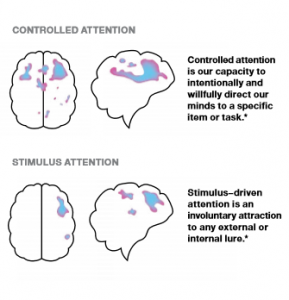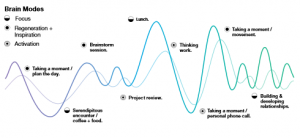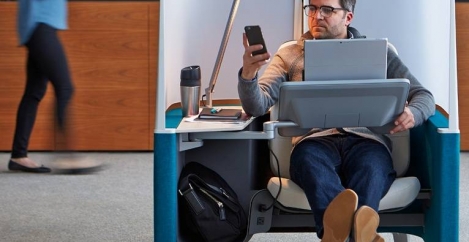June 23, 2017
Neuroscience: the next great source of competitive advantage 0
 The average worker is interrupted or distracted every three minutes and it takes them fully twenty-three minutes to return to a task after being interrupted. Office workers are overwhelmed by distractions, due mainly to a lack of understanding of how to manage attention. Distractions and the inability to focus negatively affects productivity, engagement, wellbeing and overall performance in organisations. We long to be more effective, but the harder we try, the more tired our brains become. Attention meltdowns are epidemic because workers do not understand what attention is, how to manage it or have access to the best places to support their tasks. In workplaces throughout the world scenarios of near constant distraction have become the norm, to such an extent that often people do not even feel compelled to comment on them and their consequences.
The average worker is interrupted or distracted every three minutes and it takes them fully twenty-three minutes to return to a task after being interrupted. Office workers are overwhelmed by distractions, due mainly to a lack of understanding of how to manage attention. Distractions and the inability to focus negatively affects productivity, engagement, wellbeing and overall performance in organisations. We long to be more effective, but the harder we try, the more tired our brains become. Attention meltdowns are epidemic because workers do not understand what attention is, how to manage it or have access to the best places to support their tasks. In workplaces throughout the world scenarios of near constant distraction have become the norm, to such an extent that often people do not even feel compelled to comment on them and their consequences.
![]()
 But as a result of the vast amount of neuroscience research being carried out into the effects of this on people, there is now hard evidence about what attention is, how it works, how to attain it and how to use it productively for competitive advantage. That is why we at Steelcase have presented this meta-analysis, based on the findings of neuroscientists and cognitive researchers worldwide, integrating discoveries from these experts with our own ongoing investigations into workers’ behaviours and the changing nature of work.
But as a result of the vast amount of neuroscience research being carried out into the effects of this on people, there is now hard evidence about what attention is, how it works, how to attain it and how to use it productively for competitive advantage. That is why we at Steelcase have presented this meta-analysis, based on the findings of neuroscientists and cognitive researchers worldwide, integrating discoveries from these experts with our own ongoing investigations into workers’ behaviours and the changing nature of work.
In collaboration with the distinguished neuroscientist Dr. Henning Beck, our researchers found a convergence of findings that inspired new perspectives and new ideas on the physical environment and how that environment, when thoughtfully designed, can be an effective tool to help workers better manage their attention.
There are certain key insights that are important to bear in mind when considering the nature of the brain and its role in workplace design and management. These include:
- Attention is limited and is a human’s most precious resource
- People do not know how to manage their attention
- Attention is directly linked to productivity, wellbeing, engagement and overall performance
- There are three brain modes—focus, activation and regeneration—that each require distinct behaviours and settings
- The workplace can help mitigate distractions and prime us to better manage our attention
Understanding Attention
 The prefrontal cortex, often described as the executive centre or the CEO of the brain, is the director of our attention. It’s the last major region to develop in our evolutionary history, and it’s what enables us to selectively focus on something. But there is more to attention than just the prefrontal cortex. Other brain functions that impact attention include:
The prefrontal cortex, often described as the executive centre or the CEO of the brain, is the director of our attention. It’s the last major region to develop in our evolutionary history, and it’s what enables us to selectively focus on something. But there is more to attention than just the prefrontal cortex. Other brain functions that impact attention include:
- Psychological state of arousal: Being alert or lethargic determines if we can control our attention or if our minds are unable to sit still and jump from topic to topic.
- Limbic System: Dispersed parts of the brain that deal with emotion help bring attention. Fear or excitement calls for attention more easily than neutral objects or topics.
- Motor orientation: The closer our sensory receptors are to a source of stimulation the easier it is to pay attention.
- Internal thoughts and concerns: Internally generated lapses in attention are activated by the medial prefrontal cortex, a special part of the prefrontal cortex that’s triggered by thoughts of ourselves and of other people.
Brains get tired too
The brain comprises merely 2 percent of the body’s weight but consumes more than 20 percent of the daily caloric intake of energy—more than any other organ in the human body. It therefore developed mechanisms to ensure that it doesn’t use up finite supplies. So losing attention is a simple energy-saving mechanism.
Never in history has the human brain been asked to track so many data points; people ask more of their brains than they have the energy to handle. But while the brain is on a budget, workers today are constantly trying to stretch it by putting in more hours and focusing harder.
As stress mounts, the human body is flooded with adrenaline and cortisol, which weaken our immune systems and influence our general state of mind. This results in people being in a state of over-arousal, consumed by irritation, guilt and pessimism instead of being productive.
Minds crave flow
 Contrasting dramatically with multitasking is what psychologist Mihaly Csikszentmihalyi, Ph.D., has famously named “flow”—being completely immersed in a challenge over time. It’s considered by many to be our most productive state. However, only 20 percent of people have flow moments at least once a day, while around 15 percent of people never enter flow during a typical day.
Contrasting dramatically with multitasking is what psychologist Mihaly Csikszentmihalyi, Ph.D., has famously named “flow”—being completely immersed in a challenge over time. It’s considered by many to be our most productive state. However, only 20 percent of people have flow moments at least once a day, while around 15 percent of people never enter flow during a typical day.
Entering flow is something workers must consciously choose to do. The mind can only stay in this state for about 45 minutes at any given time until a person needs a well-deserved break.
Multitasking is a myth
In today‘s workplaces, many activities compete for attention. A trend in recent years has been widespread multitasking, as workers juggle simultaneous projects and responsibilities.
Scientists have proven, however, that when we think we are multitasking, we are really switching our attention rapidly between things. Research shows that a person can’t consciously keep more than two things in their brain and that multitasking increases error rates by 50 percent.
Many people today aren‘t aware of how much they are degrading their mental processes as they attempt to multitask throughout the day. As people multitask more and more, they get worse at prioritizing and focusing on tasks.
Mindfulness trains the brain
Research from Dr. Richard Davidson at the University of Wisconsin shows that gamma rays of Buddhist monks who practiced intense meditation for years were 30 times stronger than those of a control group of college students. Instead of getting lured into distracting thoughts, the monks had trained themselves to focus at will. As little as 30 minutes of mindfulness a day for eight weeks can physiologically change the brain, according to research in the journal of Psychiatry Research.
Respect the rhythms of our brains at work
 Based on these key insights, Steelcase researchers and designers have identified three specific brain modes that workers experience during the day: Focus, Activation, Regeneration. As we become more knowledgeable about how our brains work and more attuned to the ebb and flow of our attention, it becomes easier to recognise what our brains need, and when.
Based on these key insights, Steelcase researchers and designers have identified three specific brain modes that workers experience during the day: Focus, Activation, Regeneration. As we become more knowledgeable about how our brains work and more attuned to the ebb and flow of our attention, it becomes easier to recognise what our brains need, and when.
Each of these brain modes requires its own distinct behaviours and settings. By recognizing the natural rhythms of the brain, we can create spaces that help people find focus, regeneration or inspiration and activate their brains to ultimately think better.
Brains ebb and flow between different types of attention throughout the day. Peaks and valleys in the brain’s energy make it impossible for any individual to engage in eight hours of controlled attention with any reasonable expectation of quality or quantity of output.
Workers’ tolerance for stimuli varies as they switch from analytical to group work or from routine to creative tasks. Distractions can be constructive when they fuel creativity and foster new kinds of neutral connections, but they can also be disruptive when doing focused work.
No single workplace can fully resolve the complexity of tasks workers tackle every day, so having the ability to choose spaces that help control distractions is crucial for productive work.
The need to focus
Our research has shown that in the UK only 57 percent of workers can concentrate easily and only 41 percent can choose where they can perform specific tasks within the office environment. Workplaces should therefore include places designed as retreats away from noise distractions and frequent interruptions.
When we need to deeply focus on something, it’s important to avoid unwelcome distractions. Whether the distractions are external or internal, every time we switch our attention we burn through finite neural resources and increase opportunities for the limbic system to hijack our focus.
Whether it’s turning off our phones for a while or overhauling how we manage our working day or just getting more sleep, expert authors are offering a steady stream of helpful tips, suggesting various behaviours that we can adopt to focus our brains.
Regeneration and inspiration
When we need to activate our state of arousal, moving our bodies is key. Although we may have learned otherwise in school, static sitting sabotages our ability to concentrate. Numerous studies have proven that movement boosts attention by pumping oxygen and fresh blood through the brain and triggering the release of enhancing hormones. While the physical and emotional benefits of movement are well–established, neuroscience has proven it also enhances cognition.
Activation
Although self-regulation is necessary for controlled attention, it’s important to recognize that distractions can be opportunities to give our brain the timeout it needs to function at its full potential and then let our minds go wherever they would like.
Similarly, although daydreaming has taken on generally negative connotations in the work world, it turns out that our brains are still working when they are allowed to wander freely and sometimes even work better. When we allow this, neurons in our brains are activating new pathways rather than merely focusing on what is already known, and that’s when insights really start developing.
Movement also engages the brain. A study found that those who worked from a treadmill desk were 34.9 percent more likely to answer a comprehension question correctly compared to those who sat in a chair.
The role of the workplace
Through our research we at Steelcase have found that office environments and enlightened working cultures can do a great deal to mitigate distractions and prime workers to better understand and manage their levels of attention. Like any healthy ecosystem, the workplace thrives on diversity, so it is important to provide a range of spaces that allows people to choose where and how they work. This choice has a number of benefits but one of the most important is allowing people to work in the best possible way.
Our researchers proved that there is no single type of work environment that provides the right balance between collaboration and privacy. The answer is a diverse ecosystem of spaces:
- Where people can select the right level of stimulation and informational control.
- That support different work modes (learning, socializing, coordinating, evaluating, co-creating, as well as individualized and focused work, among others).
- With a variety of public and private spaces for “I” and “We” work that are both owned and shared. • That enable people to move around and change postures.
- That have been created in partnership with workers, giving them even more sense of control.
Conclusions
Neuroscience provides a new lens through which organizations can understand cognitive wellbeing and optimize performance.
By studying neuroscience research and integrating those discoveries with our own insights into work behaviours, we were able to shed new light on the fundamental problem of distraction and how thoughtfully designed workplaces can help people better manage their attention.
We found that the workplace can be designed to mitigate distractions and prime workers to better manage their attention.
We also found that the way to increase productivity and creativity is not about expecting people to focus more, or put in more hours every day. It’s not about getting rid of an open plan and returning to the private offices and cubicles of the past. Instead, it is about getting smarter about the brain, learning its limitations and capabilities, and then using those insights to create environments that truly help people think better at work.
_____________________________________
 Beatriz Arantes is senior design researcher and psychologist at Steelcase. This article appeared originally in Work&Place. All images copyright Steelcase.
Beatriz Arantes is senior design researcher and psychologist at Steelcase. This article appeared originally in Work&Place. All images copyright Steelcase.















